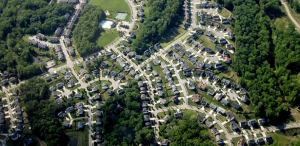In the years following World War II, the United States experienced an unprecedented consumption boom. Anything you could measure was growing. A Rhode Island-sized chunk of land was bulldozed to make new suburbs every single year for decades. America rounded into its present-day shape.
Now, though, the relentless growth in those figures is coming to an end. The AP’s Jonathan Fahey reported last week that the utility company research consortium, the Electric Power Research Institute, projected that residential electricity demand would drop over the next ten years. “From 1980 to 2000, residential power demand grew by about 2.5 percent a year. From 2000 to 2010, the growth rate slowed to 2 percent,” Fahey wrote. “Over the next 10 years, demand is expected to decline by about 0.5 percent a year, according to the Electric Power Research Institute, a nonprofit group funded by the utility industry.” That’s due, in part, to the decrease in the median size of new homes in recent years. The average size of a new home in 2010 is nearly 130 square feet smaller than in 2007.
Taken together, the end of growth in residential electricity consumption and vehicle miles traveled form a momentous signal. The United States we all grew up with is changing, or rather, it’s changed and the numbers are beginning to reflect that. The growth in housing size, electricity demand and miles traveled were the hallmarks of the suburban/exurban era. They were the statistics of sprawl — but also of economic growth. Now that their relentless upward march has stopped, what happens? We need a new model for American prosperity that doesn’t require ever greater injections of fossil energy. That’s a generational challenge that hasn’t been captured by the pro- or anti-green jobs rhetoric here in Washington.


No comments:
Post a Comment